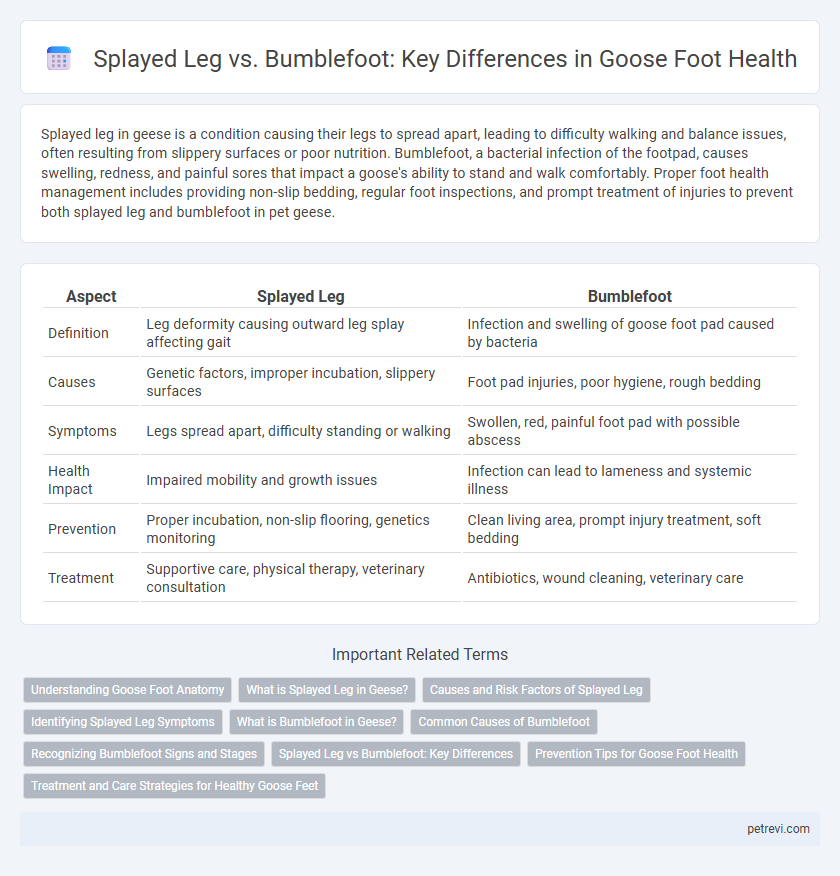Splayed leg in geese is a condition causing their legs to spread apart, leading to difficulty walking and balance issues, often resulting from slippery surfaces or poor nutrition. Bumblefoot, a bacterial infection of the footpad, causes swelling, redness, and painful sores that impact a goose's ability to stand and walk comfortably. Proper foot health management includes providing non-slip bedding, regular foot inspections, and prompt treatment of injuries to prevent both splayed leg and bumblefoot in pet geese.
Table of Comparison
| Aspect | Splayed Leg | Bumblefoot |
|---|---|---|
| Definition | Leg deformity causing outward leg splay affecting gait | Infection and swelling of goose foot pad caused by bacteria |
| Causes | Genetic factors, improper incubation, slippery surfaces | Foot pad injuries, poor hygiene, rough bedding |
| Symptoms | Legs spread apart, difficulty standing or walking | Swollen, red, painful foot pad with possible abscess |
| Health Impact | Impaired mobility and growth issues | Infection can lead to lameness and systemic illness |
| Prevention | Proper incubation, non-slip flooring, genetics monitoring | Clean living area, prompt injury treatment, soft bedding |
| Treatment | Supportive care, physical therapy, veterinary consultation | Antibiotics, wound cleaning, veterinary care |
Understanding Goose Foot Anatomy
Goose foot anatomy features webbed feet with delicate skin and strong tendons, making them prone to both splayed leg and bumblefoot conditions. Splayed leg occurs due to muscle weakness or improper hatching conditions, causing the legs to spread sideways, while bumblefoot is a bacterial infection causing swelling and sores on the foot pads. Proper understanding of foot structure and maintaining clean, dry environments helps prevent these common health issues in geese.
What is Splayed Leg in Geese?
Splayed leg in geese is a condition where the legs spread outward, causing difficulty in standing or walking, often due to weak or improperly developed tendons and muscles. This condition commonly occurs in young goslings and can result from slippery flooring or nutritional deficiencies affecting limb stability. Proper environmental management and targeted rehabilitation exercises are essential to correct splayed leg and promote healthy foot development.
Causes and Risk Factors of Splayed Leg
Splayed leg in geese primarily results from genetic predisposition, improper incubation conditions, or slippery brooding surfaces that prevent proper foot placement. Risk factors include excessive moisture, inadequate bedding, and insufficient exercise leading to weakened leg muscles and ligaments. Unlike bumblefoot, which is caused by bacterial infections and foot injuries, splayed leg is rooted in developmental and environmental issues affecting foot alignment and stability.
Identifying Splayed Leg Symptoms
Splayed leg in geese is characterized by outwardly rotated legs that prevent normal standing or walking, often accompanied by difficulty in movement and uncoordinated gait. This condition contrasts with bumblefoot, which presents as swollen, painful lesions on the foot pads rather than altered leg positioning. Early identification of splayed leg symptoms such as leg flaring and abnormal posture is crucial for effective intervention and improved goose foot health.
What is Bumblefoot in Geese?
Bumblefoot in geese is a bacterial infection affecting the foot pad, often caused by Staphylococcus bacteria entering through cuts or abrasions. This condition results in swelling, redness, and painful lesions that can impair a goose's mobility. Proper sanitation, soft bedding, and prompt treatment are essential for preventing and managing bumblefoot in geese.
Common Causes of Bumblefoot
Bumblefoot in geese is commonly caused by prolonged standing on hard or uneven surfaces, leading to pressure sores and bacterial infections on the footpad. Poor sanitation and wet environments create ideal conditions for bacteria like Staphylococcus aureus to invade minor wounds. Unlike splayed leg, which is a developmental or genetic condition affecting leg alignment, bumblefoot directly results from external environmental stressors affecting foot health.
Recognizing Bumblefoot Signs and Stages
Bumblefoot in geese manifests as swelling, redness, and dark scabs on the bottom of the foot, often starting with mild irritation and progressing to deep abscesses if untreated. Recognition involves identifying early-stage symptoms like minor inflammation and tenderness, which can escalate to limping, pus discharge, and severe swelling in advanced stages. Differentiating bumblefoot from splayed leg is crucial, as splayed leg presents with outwardly rotated legs and walking difficulties, whereas bumblefoot primarily affects foot health through infection and injury.
Splayed Leg vs Bumblefoot: Key Differences
Splayed leg in geese is a condition characterized by outwardly rotated legs, causing difficulty in walking and improper foot placement, often due to genetic or environmental factors. Bumblefoot, on the other hand, is a bacterial infection of the footpad leading to swelling, redness, and painful lesions, typically resulting from poor sanitation or injury. Proper diagnosis distinguishes splayed leg's structural issue from bumblefoot's infectious nature, guiding effective treatment and foot health management in geese.
Prevention Tips for Goose Foot Health
Splayed leg in geese can be prevented by providing non-slip flooring and maintaining a clean, dry environment to support proper leg alignment and reduce stress on the joints, while bumblefoot prevention requires regular inspection of feet for cuts or abrasions and ensuring soft, well-cushioned bedding to avoid pressure sores and infections. Nutritional support with balanced vitamins and minerals strengthens skin and tissue resilience, reducing susceptibility to both splayed leg and bumblefoot. Early intervention with proper hygiene practices and habitat adjustments ensures healthier feet and minimizes the risk of long-term mobility issues in geese.
Treatment and Care Strategies for Healthy Goose Feet
Splayed leg in geese requires supportive bandaging and maintaining a clean, dry environment to prevent worsening of foot spread, while bumblefoot demands thorough cleaning of lesions, applying antibiotic ointments, and providing soft bedding to prevent pressure sores. Both conditions benefit from regular foot inspections and isolating affected birds to minimize infection risk. Implementing proper nutrition with adequate vitamin D and calcium supports tissue repair and strengthens foot structure for long-term health.
Splayed leg vs Bumblefoot for Goose Foot Health Infographic

 petrevi.com
petrevi.com